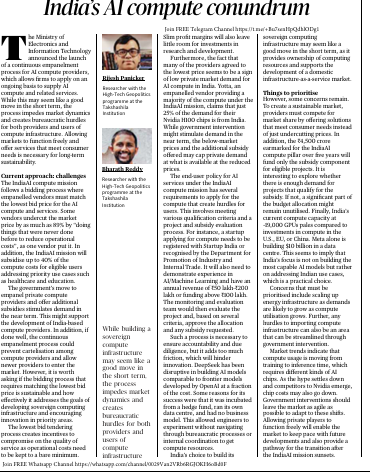🧠 Context of the Editorial:
- The editorial discusses India’s lack of AI compute infrastructure — a core requirement for training and deploying artificial intelligence models.
- It evaluates the policy vacuum, infrastructure gaps, and the need for public-private collaboration to position India as a competitive AI leader globally.
- The article coincides with the Indian government’s increased interest in rolling out a national AI strategy.
📌 Key Themes & Analysis:
1. 🧮 What is “AI Compute”? Why It Matters?
- AI Compute refers to the processing power (data centres, GPUs, TPUs, supercomputers, cloud infrastructure) required to train and deploy large AI models.
- AI innovation, especially in generative AI, demands massive compute resources. Lack of access = barrier to development.
UPSC GS Paper III: Science and Tech – Emerging Tech like AI, Cloud Computing, Data Infrastructure.
2. 🔍 Current Challenges in India’s AI Compute Ecosystem:
a. Low Availability of Compute Infrastructure:
- India lags behind the U.S. and China, where AI innovation is backed by high compute capacity.
- Indian researchers often rely on foreign cloud providers, increasing costs and data security risks.
b. High Costs and Lack of Domestic Capacity:
- Setting up compute infra needs:
- Huge capital investment,
- Reliable electricity,
- Cooling systems,
- Skilled workforce.
- Huge capital investment,
- Startups and academia suffer the most from the lack of shared access to affordable compute.
c. Underutilization of Existing Facilities:
- Public infrastructure (like C-DAC’s Param supercomputers) is underused due to bureaucratic bottlenecks and lack of coordination.
UPSC GS Paper II & III: Issues in governance, federal coordination, digital infrastructure.
3. 🏛️ Policy Gaps and Institutional Inertia:
- Despite a push for Digital India, India lacks a dedicated AI compute policy or funding mechanism.
- No national registry or mapping of existing public infrastructure for AI use.
GS II: Government policy and coordination mechanisms; GS III: Scientific innovation policy.
4. 🌍 Comparative International Experience:
- S.: Heavily funded via Department of Energy, Pentagon; collaboration with NVIDIA, OpenAI.
- EU & China: Strategic investments to build sovereign AI capability, reduce dependence on foreign cloud players.
GS II – International Comparison of Public Policy (UPSC asks such angles in Mains).
✅ Way Forward: Policy Recommendations
1. National Compute Policy
- India urgently needs a National AI Compute Mission with:
- Clear targets for compute capacity,
- Funding support for infrastructure,
- Access provisions for startups, academia.
- Clear targets for compute capacity,
2. Public-Private Partnerships (PPP):
- Encourage co-investment models with tech firms (NVIDIA, AMD, Google, etc.).
- Use case-driven infrastructure development (e.g., for healthcare AI, climate AI, agriculture).
3. Sovereign AI Strategy:
- Strategic compute capacity = technological sovereignty.
- Avoid dependency on foreign compute for national security-sensitive applications.
4. Shared Compute Cloud for India (like GigaMesh/AI Foundry):
- Allow Indian startups and researchers access to pooled infrastructure at low or subsidized cost.
5. Use of PLI and Semiconductor Mission:
- Extend PLI schemes to support AI chip design and compute infra, not just manufacturing.
📘 GS Paper II – Governance, Policies, and International Relations
“The absence of a dedicated AI compute policy in India undermines its technological sovereignty.” Discuss the importance of state intervention in shaping AI infrastructure in India.


